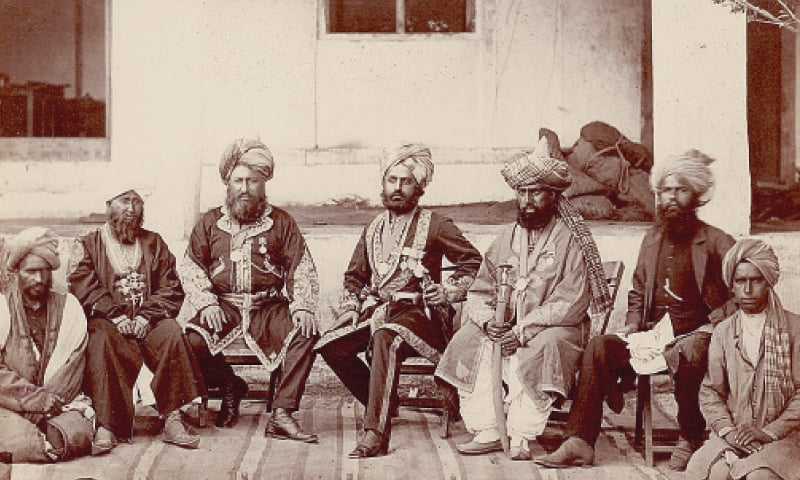Indian Merchants and Peshawar’s Connections with Central Asia in the 18th and 19th Centuries
In recent years, the Pakistan-Afghanistan border has hardened following a decision to build a fence along the colonial-era Durand Line that divided British India from Afghanistan. Islamabad’s decision to create a militarized frontier in response to the perceived danger of cross-border smuggling and terrorism gives the impression that hard borders are historical necessities. But history reminds us that the regions they divide have long been deeply entwined in terms of trade, politics and culture.
Over the past few years, scholars have been trying to incorporate eighteenth and nineteenth century Central Asia into the broader history of the global economy. In opposition to established narratives that this was a time of the decline of overland trade and regional isolationism, authors like Scott Levi in his recent book The Bukharan Crisis have sought to demonstrate Central Asia’s sustained connectedness during this period. A previous article for the Oxus Society explored an important part of this wider discussion: the networks of Hindu merchants and bankers from Shikarpur who were active in cities like Bukhara in the nineteenth century. But there were also active trade links with Peshawar, a city whose diverse people have strong cultural links to Afghanistan and Pakistan, Central, and South Asia – and which thus falls between simplified regional demarcations.
Peshawar’s location beside the Khyber Pass, and therefore at a crucial passage from Central Asia to India, has made it a transit center throughout history. Around 1786, an Indian traveler remarked that in Peshawar “all the precious and useful commodities of various countries are disposed of, and hither come the merchants of Iran, Turan [Central Asia], and Hind, to buy and sell.” Peshawar’s fertile irrigated lands grew an array of fruits, as well as a famous strain of rice. Oil, cloth and finished products like shoes or weapons were also valued: swords and gun barrels from Kohat, south of Peshawar, were of especially high quality. In the other direction, one of Central Asia’s main trade commodities was horses. Vast numbers of these were traded in the subcontinent, especially for military use. Horse merchants from Peshawar and its environs maintained bustling business in the rest of India.
In 1747, Peshawar came under the rule of the Durrani Afghans, and it remained under Durrani control until 1834 when the Sikh kingdom of Ranjit Singh annexed it. In this nearly ninety-year period, mercantile classes operating in or through Peshawar were an indispensable part of the Durrani-dominated political order, which at different times straddled modern Afghanistan, Pakistan, and parts of Uzbekistan, Iran, and India. Indians, of different creeds and origins, appear to have been the most numerous and influential financial actors in the Durrani world. Hindu, Muslim, and later Sikh traders and moneylenders, operated in and around Peshawar. The city’s traders were not only Indians; Armenians were also active in the regional trade and the city was home to a small Jewish community. Their precise occupations are unknown, but based on the activities of other Jewish traders in Central Asia, they were perhaps involved in banking or silk production and trading, or some combination of both.
Though sometimes resented, due to their role as loan-givers, these groups provided a range of services which the Durrani elites appreciated. As they embedded themselves in the countryside, rural areas could be better brought into the cash economy. This eased taxation for the ruling state, which minted and circulated coinage. Fittingly, moneylenders and traders also served as tax farmers, allowed to collect revenues provided a portion was paid to the state. The Durrani dynasty’s expensive military campaigns were heavily financed by trade groups: these wars allowed the rulers to conquer and plunder northern India and redistribute the wealth among their followers.
Stable relations with the ruling elite meant that merchants also found their way into the political arena. Moving towards and beyond the Amu Darya, past the limits of nominal and actual Durrani rule, traders from regions like Peshawar could still provide their valued services. Atma Ram, a Peshawari Hindu shopkeeper, managed to elevate himself to a high ministerial position in service to the ruler of Kunduz, Muhammad Murad Beg, in the early 1820s. When the British traveler William Moorcroft passed through and met Atma Ram in 1824, he remarked that the Peshawari trader had monopolized Kunduz’s trade with Yarkand in modern-day Xinjiang. A vivid lithograph illustration brings some life to this impressive figure, whose career also demonstrates how interconnected regions like Peshawar and Central Asia were in the eighteenth and nineteenth centuries.
One of the region’s most important trading families were the Sethis. These Punjabi financiers pledged loyalty to Durrani Emperor Ahmad Shah when he conquered Peshawar in 1747. Thereafter, the Sethi-Durrani relationship appears to have remained steady. Mian Shahab al-Din Sethi established the family’s first office at Kabul, the then-Durrani capital, in 1779. Initially based in the village of Chamkani, a few miles east of Peshawar city, the Sethis bought up a large number of properties in Peshawar city from the late eighteenth century onwards. Over time, their import and export activities in “karakul wool, copper, gold thread, skins, Russian crockery, dried fruit, and, especially tea and timber” were extended to Iran, Central Asia and northern India. Their family tradition holds that offices were established even further, in Shanghai or Vladivostok.
Trade in Chinese and Indian tea with Central Asia was especially important. Despite their substantial connections with the Durrani amir Abd al-Rahman (r. 1880-1901)’s government, the Sethis aimed to circumvent his heavy-handed taxation and confiscation policies. A system developed, in cooperation with other Muslim, Hindu, and Jewish financiers in Bukhara, whereby northern Indian tea was moved over sea routes rather than overland through Afghanistan. Cash from its sale was wired to Moscow, and from Moscow to Bombay, where it could be paid to the Peshawari merchants in a fascinating example of transnational capital flows.
It was no accident that the Sethis pledged themselves so quickly to Ahmad Shah Durrani. Their main patron in Chamkani was an influential Sufi Shaykh, Mian Muhammad Umar, who was also Ahmad Shah’s spiritual guide, and that of many Durrani nobles. The Shaykh was part of another potent transregional network of the day: that of Mujaddidi-Naqshbandi Sufis. This Sufi order, founded in Sirhind in northern India, found itself drawn to the territories of the Durranis, as well as the Central Asian khanates and their successors in the later eighteenth century due to political instability, and especially a violent attack on Sirhind by a Sikh force in 1763.
Like the traders, these mystics provided ruling states with administrative services, but also with vital spiritual legitimacy. Members of the order established lodges as far west as the Ottoman Empire, and circulated numerous texts throughout South and Central Asia. In Bukhara, the prominent Peshawari Sufi leader Hazrat Jio Sahib established himself in service to the Manghit ruler Shah Murad (r. 1785-1800), initiating him into the Mujaddidi order. Beyond his personal piety, Shah Murad would have been drawn to a figure like Jio Sahib as a useful partner in his quest “to reassert Bukhara’s position as the political and academic center of [Transoxiana].”
Even in the 18th century, the frontier between modern Afghanistan and Pakistan could be dangerous. One Armenian trader remarked to East India Company agent George Forster that he refused to take the Khyber Pass, preferring instead to take a circuitous southern route that took weeks longer, due to safety concerns. But the region’s early modern condition was one of continual movement of different religious and ethno-linguistic groups migrating and interacting across the spaces we now deem cleanly demarcated by international borders. As these borders harden, it is worth remembering that the histories of Central Asia, India, Pakistan and Afghanistan, and their people, remain intertwined and cannot be separated unless by deliberate erasure.
Timur Khan is a research Master’s student of Middle Eastern Studies at Leiden University. His work focuses on statecraft and legitimacy in the Durrani period of Peshawar’s history (c. 1747-1834). His research interests include early modern and colonial territoriality, the cultural and political history of Afghans within the Turko-Persianate world, and the role of non-Europeans in the making of 19th-century colonial empires. His Twitter is @TimurKhan97.




